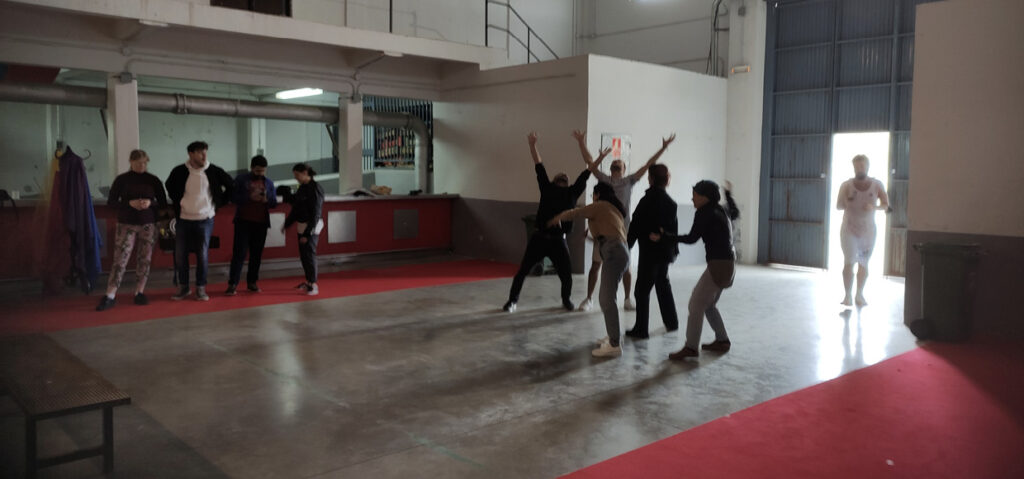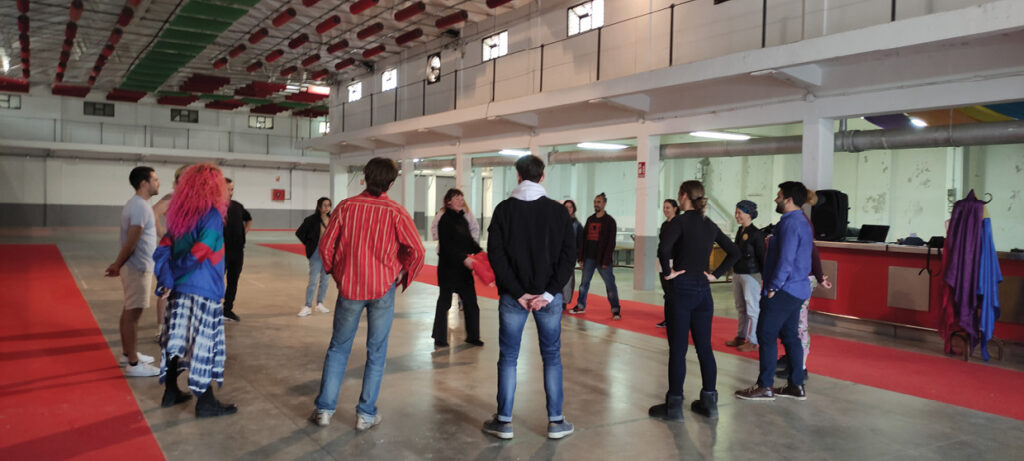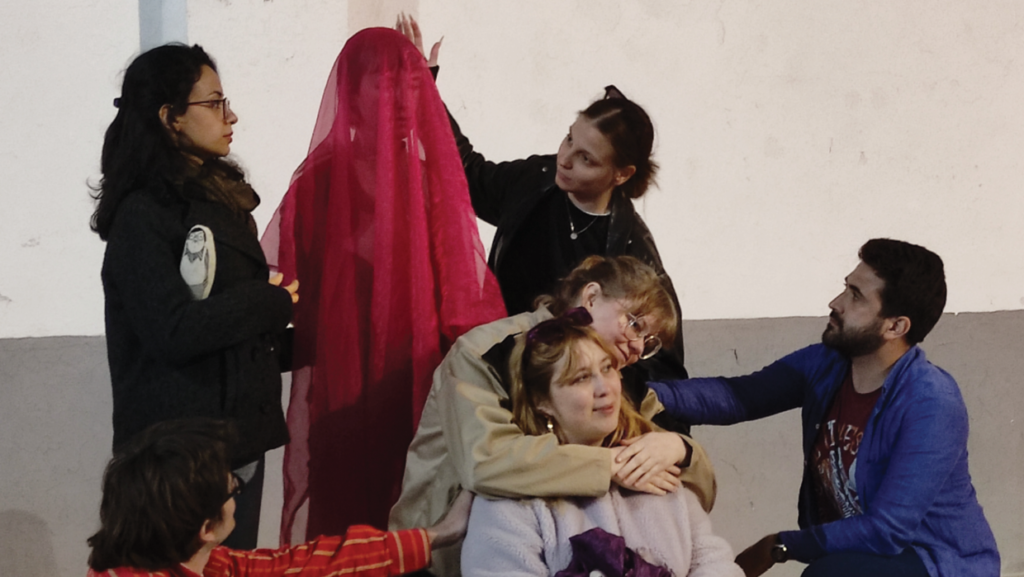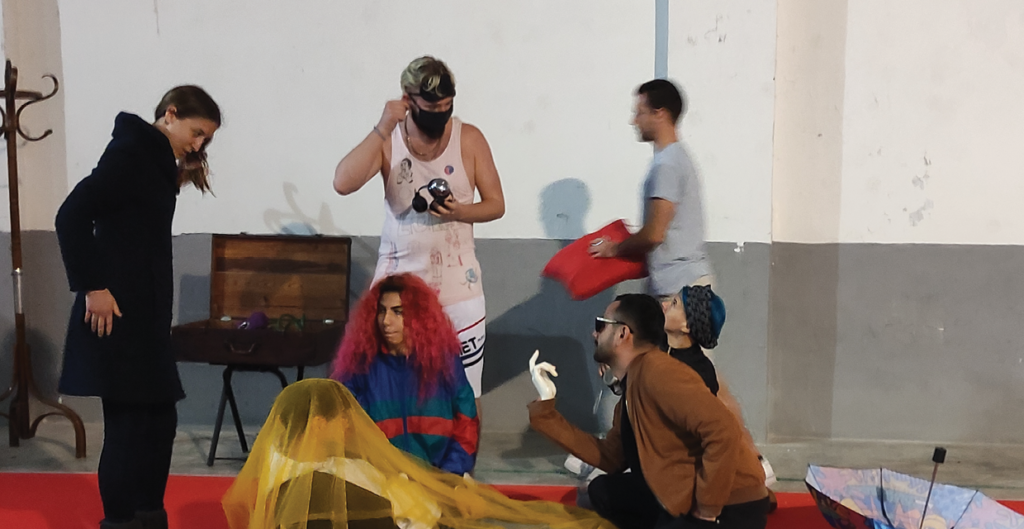Theme
- Social peace
- Non-verbal communication as divergent thinking.
Objectives
- To develop an inner listening of my emotional world
- To work on the concept of inclusion and equality with a proposal of horizontal exercises that allow sharing, reflecting and debating the experience in search of new ways
- To promote creativity, forms and capacities from Dance/Theater for use with others and the environment.
- To develop an inclusive and empathetic body language with the environment within the concept of Peace
Duration
- 90 minutes :Dance Theatre
- 30 minutes :5 Rhythms and Authentic movement
Materials
- Diaphanous space and prepared to dance 10m x10m minimum.
- Specific music session for the development of the 5rytmos (see at the end of the session)
- Stereo
- 1 microphone for the facilitator
- White sheets (50 units)
- 5 black markers
- Fruits and enough water for 20 people
Recommended Method
Preperation
People will go through a body and emotional search through the four types of movement proposed by the 5 Rhythms, fluid, staccato, chaos, lyrical and stillness. Each rhythm is connected with a part of us and our emotions, it is a practice towards listening to ourselves and others from the body and dance and each rhythm has a body shape to develop it, making the participants go through those body shapes immersed in a different, divergent form of communication with myself and with others.
Body Theaters
Structure of the activity
- Opening
- Relaxation
- Dance and movement
- Share in two
- Share the activity with the group and close
1)Opening (10min)
In the opening, what we have to achieve is that all the people who are going to participate in the practice feel comfortable and confident with the rest that surrounds them.
For this we are going to facilitate a couple of games that make a group and trust us:
They are invited to form a circle in the center of the space leaving a space between each one for the development of movements.
Games
1-The names
We make a circle with all the people and make them take a step forward from the place they occupy and say their name and make a gesture of welcome to the group with their body, this will be done by all the people one by one. the counterclockwise direction.
2-Nobody like me
Keeping the previous circle, we move on to the second game, this will be done 1 by 1 in no established order, but it is important that everyone show up.
Presentation and resonance exercise or group identification
From that same circle now each person one by one will go to the center of the circle and will present themselves as follows:
a)Nobody like me ….
Facilitator asks her to come to the center of the circle and say the phrase “No one like me” and complete it with something that she thinks no one does like her or that she likes the way she does it…
For example,
no one like me … take a nap,
no one like me… kisses,
nobody like me… cooks bread, etc.
b)Once the person has been introduced, if someone identifies with what the person in the center of the circle said, they also move to the center and join the one who has been introduced.
2)Relaxation (15min)
a)Recognize the space
We make them walk through the space observing every detail of the room or space in which we will carry out the activity, once displaced by it we will suggest that they choose a place individually in which they will carry out the activity.
b)Breathing and relaxation
We make them close their eyes and synchronize their breathing, we suggest that they breathe in while the facilitator counts to 3 and breathe out at the same time.
Eg We breathe in on 1, 2, 3 and breathe out on 1, 2, 3.
We perform this activity with eyes closed for 3 min.
3)Dance Session 5 Rhythms and Authentic movement. (30 min Approx)
With the participants relaxed and each one in their place we will begin the dance session, the music begins to play… this music will be subdivided into five musical forms that lead us and invite us to each development that we will detail below.
Music that will be used for the development of the aforementioned activity.
Example Video : https://www.youtube.com/watch?v=CA_RlOzHlSI
Text that will be used to encourage the participants in each rhythm to achieve a deep inner work through dance – Theater
1-Fluid(5 mins)
The music begins to play and we will propose to the dancers to let themselves be carried away by the music and begin to move little by little as they feel organically moving.
Little by little the facilitator will propose to the participants to start making very subtle movements, from the idea of a circular, fluid, continuous movement, we can draw in the air with our arms, our legs, feet, hips, heads generating an uninterrupted movement circular, in a fractional way with the parts of our body and also with the whole body at the same time.
While the dance is taking place, the facilitator can share this text with the participants as a form of mantra or help to deepen the emotional world of the people who dance.
Text:
“We physically practice the art of being fluid in our bodies. Flow is the path to our inner truth, the drive to follow the flow of one’s own energy, to be true to ourselves, to listen and attend to our needs, and to be receptive to our inner and outer worlds.”
2-Staccato
Once the following rhythm is entered, the dancers will be proposed to vary the form of movement. The music is modified, it is already a quality of music with more marked forms, this invites us to a body movement with more defined intentions, rectilinear movements, cutting and sharp, we propose from a more intense energy, with more projection of the extremities. We suggest mechanical, mechanical, emphatic, expressive, rigid movements.
Text:
“This rhythm is the ruler of our linear world, the ruler of our warrior part, the part of us that stands as truth and clarity. He is the part of us that defends what matters to us, that we like. Staccato is the fierce master of limits”
3-Chaos
In this rhythm we will suggest to the participants that we leave the straight and circular forms to enter a space of movement where the body does what it feels, without established forms, without instructions, move intuitively to where the music takes us, move faster than what we can think, we don’t think how to move but we move in the here and now as the body and the music suggest.
Note: In this rhythm the facilitator intervenes as little as possible.
We accompany only with the text:
“It consists of letting go, allowing, inviting, encouraging, letting go; simply by concentrating and letting what we call the ordinary mind take a backseat to the movement”…
4-Lyrical
In this rhythm we will propose to the dancers the integration of the previously transited movements, we go through fluid body movements, staccato, chaotic, we integrate all the movements and we seek through music to offer our dance outwards, towards the sky, towards the earth. towards others…
We suggest that you think of something or someone EU is in the sky and give them your dance, the idea is that the vector of movement is upwards.
Text:
“It connects us with humanity, it is more a state of being than a rhythm. We become light on our feet, like birds flying in the air, but make no mistake, lyrically we are grounded and fully empowered.”
5 – Stillness
After having gone through the fluid, circular movements, staccato, angular and straight movements, chaos, freeing the body without thinking, Lirico offering our movement integrated with the other 3 rhythms, stillness arrives.
In this rhythm we are not going to give directed slogans, but we are only going to verbalize that we live the stillness as each one feels it, it can be through a movement, through physical stillness… the idea is that each one lives his own integration of what has been dancing and experiencing during the development of the session.
Text:
“The stillness moves, within and around us. Moving still and still moving merges our body’s accumulation of life experiences into our true wisdom.”
End of the musical session, we leave a few minutes for them to get up after practice, drink water, go to the bathroom and recover their daily energy.
4)Share with a company
Once these minutes have passed, we will propose that they choose a person in the room, sit face to face and that in 5 minutes (2.30 min each) they share their experience of what they lived.
They are asked to pair up sitting on the floor facing each other and one at a time tell the other,how did you live the experience?
Where did you find your resistance or if you always repeated the same movement?
What if you discovered different and new ways of expressing your body through dance?
Both are grateful for the possibility of sharing their experience with the other and they are all gathered in the center in a large circle to share with the group the total experience of the activity.
5)Share with the group, Integration and closure
After sharing with a colleague, we invite everyone to make a circle again and we sit down.
The idea is to invite them to share with the group through their experience,
How do we feel after practice?
What does the practice of authentic movement bring us now in oral expression?
Do we believe that it contributes to the daily practices of inclusion, equality and peace?
What group forms could we implement for that search with this practice in our daily life?
Closing:
An appetizer based on water with slimes and fruits is recommended to share with the group at the end of the session.
Tips for Facilitators
1-It is important to communicate to people that this practice is about an authentic and personal movement, colored by our abilities and possibilities, therefore, understanding that it is a session of 25-30 min of movement, it is not about making a super deployment physical or dancer or ballerina, but dose and listen to my own possibilities to carry out the entire activity.
2-Always have water nearby to hydrate and if possible fruits.
3-As an option, it is recommended to collect the points shared by the group in the integration and closing group sharing and turn it into a text that serves as evidence and suggestions as ways of approaching and growing the researched work.
Additional Readings
5Rytmos music session by Gabrielle Roth, creator and founder of the 5Rytmos movement and technique




